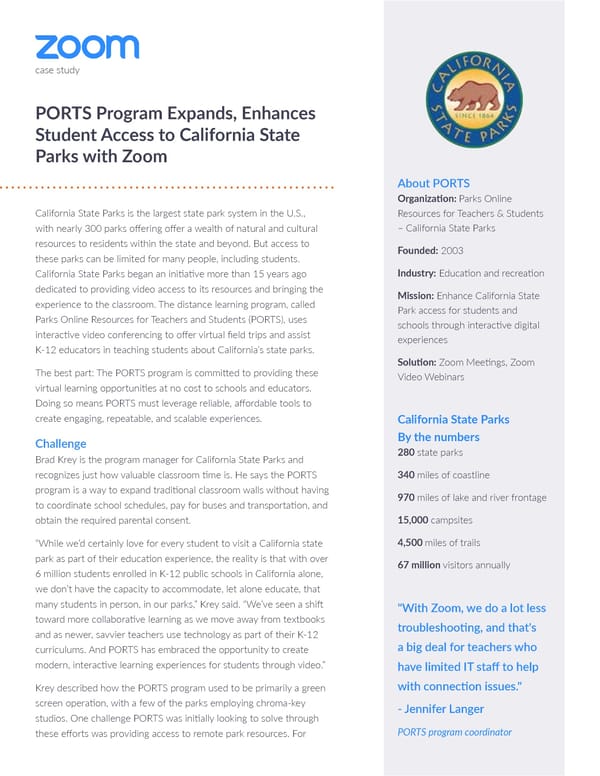case study PORTS Program Expands, Enhances Student Access to California State Parks with Zoom About PORTS Organization: Parks Online California State Parks is the largest state park system in the U.S., Resources for Teachers & Students with nearly 300 parks offering offer a wealth of natural and cultural – California State Parks resources to residents within the state and beyond. But access to Founded: 2003 these parks can be limited for many people, including students. California State Parks began an initiative more than 15 years ago Industry: Education and recreation dedicated to providing video access to its resources and bringing the Mission: Enhance California State experience to the classroom. The distance learning program, called Park access for students and Parks Online Resources for Teachers and Students (PORTS), uses schools through interactive digital interactive video conferencing to offer virtual field trips and assist experiences K-12 educators in teaching students about California’s state parks. Solution: Zoom Meetings, Zoom The best part: The PORTS program is committed to providing these Video Webinars virtual learning opportunities at no cost to schools and educators. Doing so means PORTS must leverage reliable, affordable tools to create engaging, repeatable, and scalable experiences. California State Parks Challenge By the numbers Brad Krey is the program manager for California State Parks and 280 state parks recognizes just how valuable classroom time is. He says the PORTS 340 miles of coastline program is a way to expand traditional classroom walls without having 970 miles of lake and river frontage to coordinate school schedules, pay for buses and transportation, and obtain the required parental consent. 15,000 campsites “While we’d certainly love for every student to visit a California state 4,500 miles of trails park as part of their education experience, the reality is that with over 67 million visitors annually 6 million students enrolled in K-12 public schools in California alone, we don’t have the capacity to accommodate, let alone educate, that many students in person, in our parks,” Krey said. “We’ve seen a shift "With Zoom, we do a lot less toward more collaborative learning as we move away from textbooks troubleshooting, and that's and as newer, savvier teachers use technology as part of their K-12 curriculums. And PORTS has embraced the opportunity to create a big deal for teachers who modern, interactive learning experiences for students through video.” have limited IT staff to help Krey described how the PORTS program used to be primarily a green with connection issues." screen operation, with a few of the parks employing chroma-key - Jennifer Langer studios. One challenge PORTS was initially looking to solve through these efforts was providing access to remote park resources. For PORTS program coordinator
 Top UCaaS Case Studies Page 71 Page 73
Top UCaaS Case Studies Page 71 Page 73